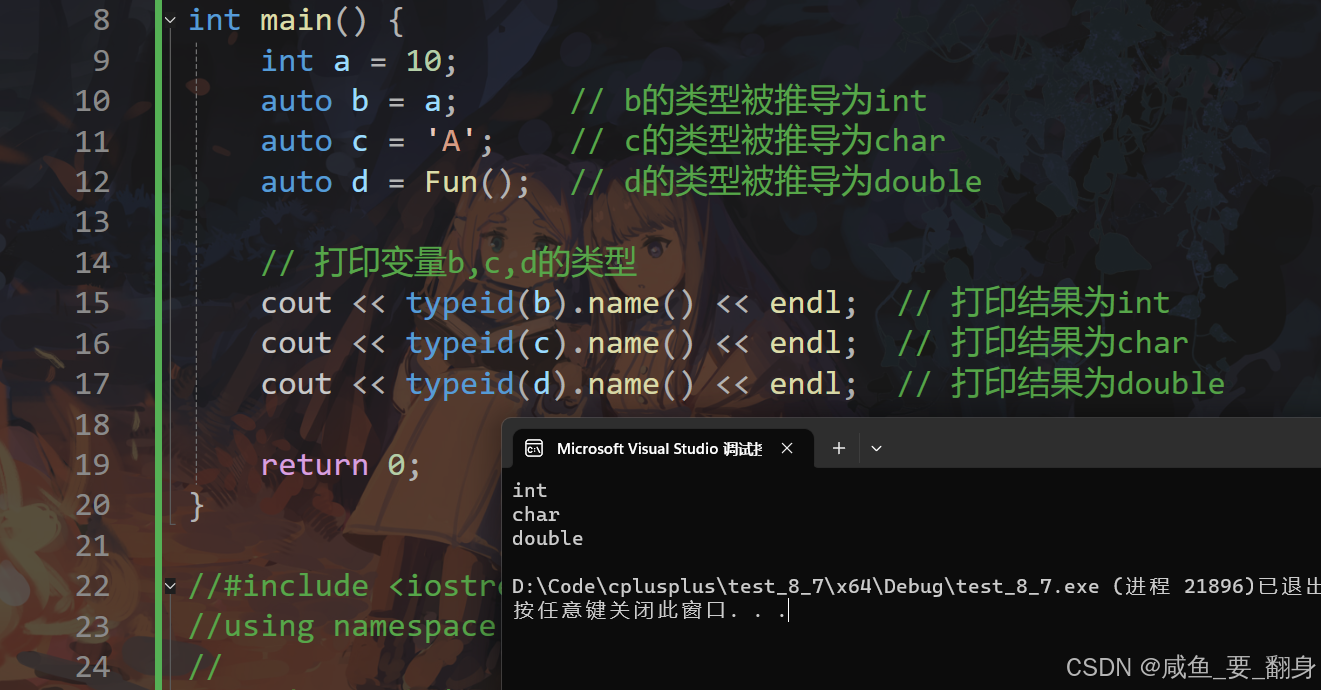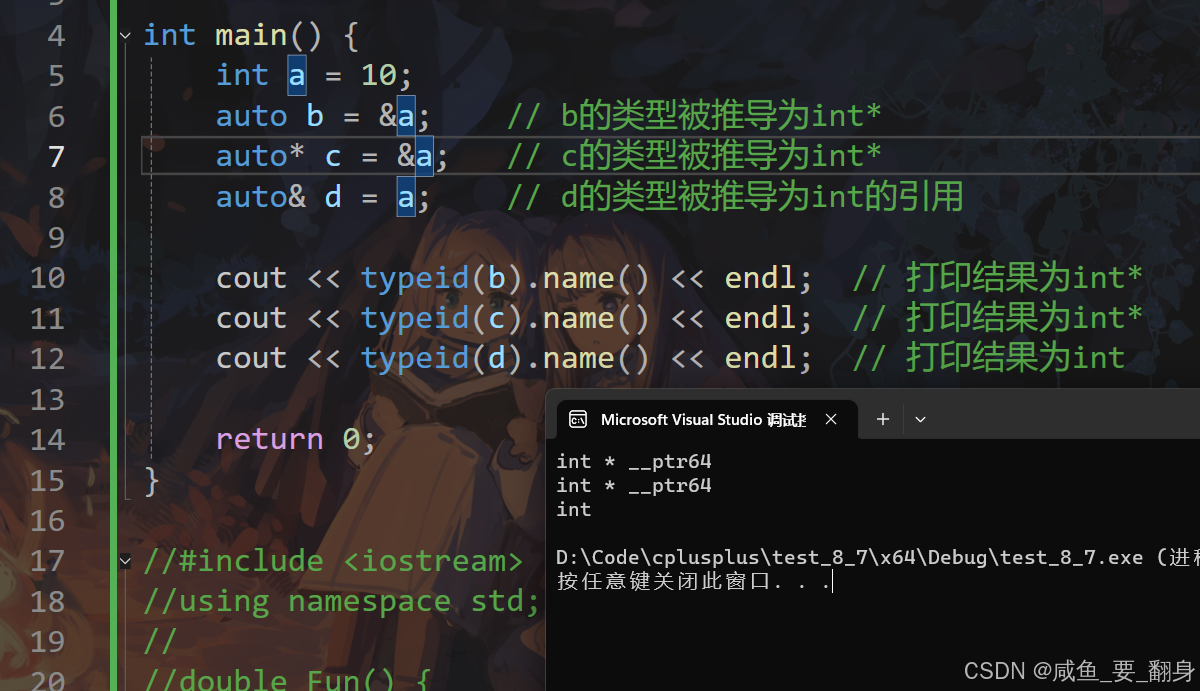C++11 auto关键字:智能类型推导指南
目录
一、auto关键字简介
重要注意事项:
二、auto的使用细则
1、auto与指针和引用结合使用
2、在同一行定义多个变量
三、auto 的优势
1、简化复杂类型声明
2、避免类型名称冗长
3、确保变量类型正确
四、auto 的推导规则
1、值类型推导(去除引用和顶层 const)
2、引用和 const 的保持
五、auto不能推导的场景
1、auto不能作为函数参数
2、auto 可以作为函数返回值(C++14 起),但是建议谨慎使用
为什么建议谨慎使用 auto 返回值?
3、auto不能直接用来声明数组
4、auto的其他限制
六、auto 的特殊用法
1、auto 用于函数返回类型(C++14)
2、decltype(auto)(C++14)
3、结构化绑定(C++17)
七、auto的实用场景
1、简化复杂类型声明
2、与lambda表达式结合使用
3、返回值类型推导(C++14起)
4、模板编程
5、范围 for 循环
八、auto 的注意事项
1、必须初始化
2、不要滥用
3、与代理对象的问题
4、auto 推导出非预期类型
九、最佳实践建议
一、auto关键字简介
在早期的C/C++中,auto的含义是:使用auto修饰的变量是具有自动存储期的局部变量。然而,由于局部变量默认就是自动存储期的,这一用法几乎无人使用。
C++11标准委员会赋予了auto全新的含义:auto不再是一个存储类型指示符,而是作为一个类型推导指示符。编译器会在编译时期根据初始化表达式自动推导auto声明的变量类型。
#include <iostream>
using namespace std;double Fun() {return 3.14;
}int main() {int a = 10;auto b = a; // b的类型被推导为intauto c = 'A'; // c的类型被推导为charauto d = Fun(); // d的类型被推导为double// 打印变量b,c,d的类型cout << typeid(b).name() << endl; // 打印结果为intcout << typeid(c).name() << endl; // 打印结果为charcout << typeid(d).name() << endl; // 打印结果为doublereturn 0;
}
重要注意事项:
-
使用
auto变量时必须进行初始化,编译器需要根据初始化表达式来推导实际类型 -
auto不是一种"类型"声明,而是一个类型声明的"占位符" -
编译器在编译期会将
auto替换为变量实际的类型
二、auto的使用细则
1、auto与指针和引用结合使用
-
用
auto声明指针类型时,auto和auto*没有区别 -
用
auto声明引用类型时必须加&,否则创建的只是与实体类型相同的普通变量。
#include <iostream>
using namespace std;int main() {int a = 10;auto b = &a; // b的类型被推导为int*auto* c = &a; // c的类型被推导为int*auto& d = a; // d的类型被推导为int的引用cout << typeid(b).name() << endl; // 打印结果为int*cout << typeid(c).name() << endl; // 打印结果为int*cout << typeid(d).name() << endl; // 打印结果为intreturn 0;
}
2、在同一行定义多个变量
在同一行声明多个auto变量时,这些变量必须是相同类型,否则编译器将会报错,因为编译器只对第一个类型进行推导,然后用推导出的类型定义其他变量。
int main() {auto a = 1, b = 2; // 正确,都是int类型auto c = 3, d = 4.0; // 错误:"auto"必须始终推导为同一类型return 0;
}三、auto 的优势
1、简化复杂类型声明
std::vector<std::string> names;
// 不用 auto
std::vector<std::string>::iterator it = names.begin();
// 使用 auto
auto it = names.begin();2、避免类型名称冗长
auto ptr = std::make_shared<std::vector<std::string>>();3、确保变量类型正确
auto result = computeSomething(); // 不必关心 computeSomething() 的具体返回类型四、auto 的推导规则
auto 遵循模板参数推导的规则:
1、值类型推导(去除引用和顶层 const)
int x = 10;
const int cx = x;
const int& rx = x;auto a = x; // a 是 int
auto b = cx; // b 是 int (去除了 const)
auto c = rx; // c 是 int (去除了 const 和引用)2、引用和 const 的保持
使用 auto& 或 const auto& 可以保留引用和 const 属性:
auto& d = x; // d 是 int&
auto& e = cx; // e 是 const int&
const auto& f = x; // f 是 const int&五、auto不能推导的场景
1、auto不能作为函数参数
以下代码编译失败,auto不能作为形参类型,因为编译器无法对x的实际类型进行推导。
void TestAuto(auto x) {} // 编译错误:auto不能作为形参类型2、auto 可以作为函数返回值(C++14 起),但是建议谨慎使用
从 C++14 开始,auto 可以作为函数返回类型,编译器会根据 return 语句推导返回类型。
auto add(int a, int b) { // 返回类型由 return 语句推导return a + b; // 推导为 int
}auto getValue(bool flag) {if (flag) {return 10; // 返回 int} else {return 3.14; // 返回 double → 编译错误:推导冲突!}
}int main() {auto result1 = add(3, 4); // result1 是 intauto result2 = getValue(true); // 如果 getValue 能编译,result2 可能是 int 或 doublereturn 0;
}为什么建议谨慎使用 auto 返回值?
虽然 auto 返回值很方便,但可能导致 可读性下降 或 意外类型推导:
-
所有
return语句必须返回相同类型-
如果
return返回不同类型(如int和double),编译器会报错。 -
例如,
getValue()函数会因为return 10和return 3.14类型不同而编译失败。
-
-
代码可读性降低
-
如果函数实现较长,阅读代码时可能不清楚返回类型是什么。
-
例如:
auto computeSomething(int x, double y) {// 很长的计算过程...return x * y + 100; // 返回类型是 double 还是 int? }如果函数逻辑复杂,
auto可能让调用者难以预测返回类型。
-
-
可能影响接口稳定性
-
如果修改
return语句的类型,所有调用该函数的代码可能受到影响。 -
例如:
auto getValue() {return 42; // 最初返回 int } // 后来修改为: auto getValue() {return 42.0; // 现在返回 double → 可能破坏现有代码! }
-
3、auto不能直接用来声明数组
int main() {int a[] = {1, 2, 3};auto b[] = {4, 5, 6}; // 错误:数组不能包含auto类型元素return 0;
}4、auto的其他限制
-
auto变量必须初始化 -
auto不能用于非静态成员变量 -
auto不能用于函数模板参数(C++20之前)
六、auto 的特殊用法
1、auto 用于函数返回类型(C++14)
auto add(int a, int b) {return a + b;
}2、decltype(auto)(C++14)
完全保留表达式的类型(包括引用和 const):
int x = 0;
const int& crx = x;auto a = crx; // a 是 int
decltype(auto) b = crx; // b 是 const int&3、结构化绑定(C++17)
std::pair<int, std::string> p{1, "hello"};
auto [id, name] = p; // id 是 int, name 是 std::string七、auto的实用场景
1、简化复杂类型声明
auto特别适用于简化复杂类型的声明,如迭代器:
#include <iostream>
#include <string>
#include <map>
using namespace std;int main() {map<string, string> dict = {{"apple", "苹果"},{"orange", "橙子"}, {"pear", "梨"}};// 传统方式map<string, string>::iterator it1 = dict.begin();// 使用auto简化auto it2 = dict.begin();while (it2 != dict.end()) {cout << it2->first << ":" << it2->second << endl;++it2;}return 0;
}2、与lambda表达式结合使用
auto lambda = [](int x, int y) { return x + y; };3、返回值类型推导(C++14起)
从C++14开始,auto可以用于函数返回类型推导:
auto add(int a, int b) {return a + b; // 返回类型被推导为int
}4、模板编程
template <typename T, typename U>
auto add(T t, U u) -> decltype(t + u) {return t + u;
}5、范围 for 循环
for (auto& item : container) {// ...
}八、auto 的注意事项
1、必须初始化
auto x; // 错误:无法推导类型2、不要滥用
-
当类型显而易见时可以使用
-
当类型很重要或有助于代码可读性时,应显式写出类型
3、与代理对象的问题
std::vector<bool> vec = {true, false};
auto b = vec[0]; // b 是 std::vector<bool>::reference,不是 bool4、auto 推导出非预期类型
auto s = "hello"; // s 是 const char*,不是 std::string九、最佳实践建议
-
在类型名称较长或复杂时优先使用
auto,优先使用auto来声明局部变量 -
当类型显而易见时使用
auto提高代码可读性 -
避免在不必要的简单类型上使用
auto(如auto x = 0;) -
对于引用类型,记得使用
auto&或const auto& -
在C++11/14中谨慎使用
auto作为返回类型 -
当需要精确控制推导类型时,考虑使用
decltype(auto) -
避免在不必要的长作用域中使用
auto,可能会降低代码可读性
auto关键字是C++11引入的一项重要特性,合理使用可以显著提高代码的可读性和编写效率,但也需要注意其适用场景和限制。
